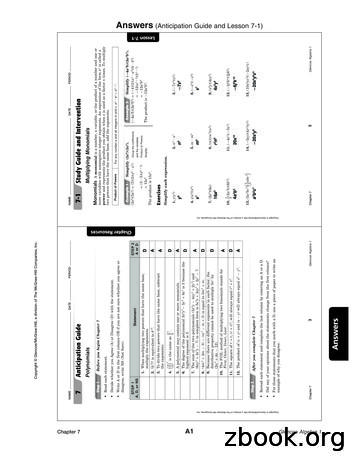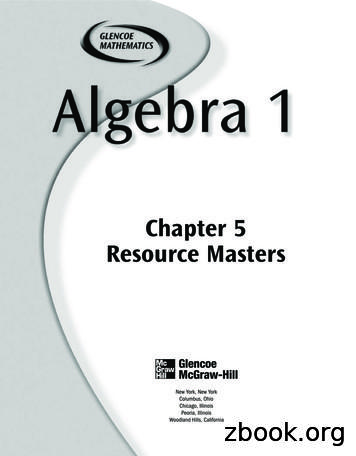Copyright Glencoe/McGraw-Hill, A Division Of The McGraw-Hill .
Copyright Glencoe/McGraw-Hill, a division of The McGraw-Hill Companies, Inc. What Lies Beneath? Do deposits of oil or natural gas lie deep beneath this section of the ocean? The owners of these exploration rigs hope so. These rigs are used to drill small test wells in the ocean floor. If the tests are successful, then larger platforms and larger wells will be built. 1 Oil rigs are expensive to build and operate, especially in the ocean. Why do companies invest time and money searching for oil? 2 Could spilled oil damage the ocean environment? Explain. 3 Why do oil companies keep searching for oil reserves instead of continuing the operation of existing wells? Natural Resources Bellringer LESSON 1X
Copyright Glencoe/McGraw-Hill, a division of The McGraw-Hill Companies, Inc. Drilling for Petroleum Water between spaces in rock Natural gas Impermeable rock Oil Impermeable rock Natural Resources Focus on Content LESSON 1
Copyright Glencoe/McGraw-Hill, a division of The McGraw-Hill Companies, Inc. A Different Kind of Farm Have you ever seen a farm without crops or animals? This is a photo of a wind farm. The turning blades of the turbines are used to make electricity. Today, wind power accounts for less than 1 percent of the electricity produced in the United States. Wind turbines are expensive to build. But if the cost of coal and oil continues to rise, wind farms might become a more economical choice. 1 Why is this land an ideal location for a wind farm? 2 What are some benefits and drawbacks of wind power? 3 Do you think a wind farm would be practical in or near your community? Discuss. Natural Resources Bellringer LESSON 2X
Copyright Glencoe/McGraw-Hill, a division of The McGraw-Hill Companies, Inc. Geothermal Energy Generator Cooling tower Turbine Hot water Natural Resources Cool water Focus on Content LESSON 21
Copyright Glencoe/McGraw-Hill, a division of The McGraw-Hill Companies, Inc. Field of Stumps Within a few days, loggers can change a forest into a field of stumps. But the field will not remain barren permanently. After the stumps are cleared, new trees can be planted in their places. Or the land can be used for farming or ranching. 1 Why are trees valuable? What do you think happened to these trees after they were cut down? 2 Have forests or stands of trees been cut down recently in your community? If so, what replaced them? 3 What are the advantages and disadvantages of cutting down a forest? Discuss. Natural Resources Bellringer LESSON 3X
Copyright Glencoe/McGraw-Hill, a division of The McGraw-Hill Companies, Inc. Height of the Forest Canopy: 1650—1992 Canopy Height (m) 0 10 20 30 1650 Natural Resources 1992 Focus on Content LESSON 3
Copyright Glencoe/McGraw-Hill, a division of The McGraw-Hill Companies, Inc. A Lake in the Desert Much of the land of Utah and Arizona is dry and rocky. This lake is an exception. Lake Powell was created when the Glen Canyon Dam was built on the Colorado River. Ever since the dam opened in the 1960s, both the canyon and the river have changed greatly. 1 What benefits does Lake Powell provide? 2 How has Glen Canyon Dam changed the land and the river? Are all the changes beneficial? Discuss. Natural Resources Bellringer LESSON 4
Copyright Glencoe/McGraw-Hill, a division of The McGraw-Hill Companies, Inc. Smog 1 During winter, the Sun supplies less warmth to Earth’s surface. 2 3 Natural Resources Sometimes warmer air traps colder air and acts as a lid, holding cold air near the ground. A layer of pollution from vehicles, industry, and homes is trapped by the warm air. Focus on Content LESSON 4
Teacher Guide Natural Resources Lesson 1 Bellringer Copyright Glencoe/McGraw-Hill, a division of The McGraw-Hill Companies, Inc. Creatas/PunchStock What Lies Beneath? Oil companies spend millions of dollars every year exploring new oil reserves. Their investments tend to increase or decrease with the price of crude oil. As of 2009, the U.S. government allows offshore oil drilling only along certain sections of its coastline. The issue of developing oil wells along more of the coastline has been a topic of much public debate. Proponents argue that the United States needs more oil and should tap all of its resources. Opponents argue that the environmental risks of offshore drilling are high and that more investments should be made in alternative energy resources. Answers to Questions 1 Companies invest in the search for oil because oil is very valuable. Products made from oil include gasoline and diesel fuels, which power cars and other vehicles all over the world. 2 Yes. Oil spills in the ocean can spread oil far along the water’s surface. It can contaminate beaches and kill marine life, and it is difficult to clean up. 3 Oil wells produce only so much oil before they run dry. For oil to be available in the future, new reserves must be found. Lesson 1 Focus on Content Drilling for Petroleum Scientists theorize that oil and natural gas formed from the remains of plankton that lived in oceans. Yet oil deposits can be found beneath land as well as oceans. The reason oil can be found beneath land is because Earth’s tectonic plates have shifted greatly over millions of years since the plankton existed. Lesson 2 Bellringer CORBIS A Different Kind of Farm Wind farms have become common sites in many windy regions, including the deserts of Southern California and Arizona. Other wind farms coexist with agricultural land use. Winds form because the Sun heats Earth unevenly. For this reason, wind power can be considered a form of solar energy. Answers to Questions 1 This desert land provides poor conditions for other uses, such as farming or ranching. Therefore, the wind turbines are not a disruption to these activities. The lack of trees and the rapidly changing temperatures allow winds to blow strongly. 2 Some advantages are that the wind is a free, inexhaustible, and easily attainable energy source. Wind turbines do not add pollutants to the air and can operate indefinitely. Some disadvantages are the expense of building wind turbines and their reliance on consistent and strong winds. 3 Answers will vary with location. Encourage students to investigate whether wind turbines or wind farms provide energy in their region. Lesson 2 Focus on Content Geothermal Energy Geothermal power plants use the thermal energy from Earth’s interior to heat water and change it into steam. Other power plants use the steam to turn turbines and generate electricity. Power plants that run on geothermal energy provide a large percentage of the electricity in Iceland, an island nation in the northern Atlantic Ocean. The land in Iceland is formed from volcanoes, many of which remain geologically active. Lesson 3 Bellringer Brand X Pictures/Punchstock Field of Stumps When European settlers first encountered North America, much of the land was covered in forests. As the population grew, the forests were cut down in part for their wood, but mostly to make room for agricultural land use and eventually for large cities and suburbs. Answers to Questions 1 Trees provide wood, which is used to build houses and furniture and to make paper and other products. After these trees were cut down, their trunks most likely were brought to lumber mills or paper mills to be processed. 2 Answers will vary with location. In many communities, stands of trees (a group of trees with similar characteristics) are often cut down to make room for new housing or commercial developments. 3 Advantages include gaining land for farming and ranching, and supplying lumber and paper. Disadvantages include destroying a natural ecosystem that is home to a diverse wildlife community. Trees also help prevent soil erosion and flooding. Lesson 3 Focus on Content Height of the Forest Canopy: 1650–1992 The U.S. population of trees has changed, not only because forests have been cut down, but also because diseases and pests have taken their toll. For example, when many cities were established, elms and oaks were often planted along the streets. In the mid-twentieth century, both of these tree types were struck with diseases that greatly reduced their number. Disease has also effectively obliterated the American chestnut, which was once common throughout eastern forests.
Teacher Guide continued Lesson 4 Bellringer Scenics of America/PhotoLink/Getty Images Copyright Glencoe/McGraw-Hill, a division of The McGraw-Hill Companies, Inc. A Lake in the Desert Over the past 50 years, the populations of cities in Utah, Arizona, Nevada, and Southern California have all risen sharply. Many of these cities, as well as the farms and ranches in each region, rely on the Colorado River for their supply of freshwater. Today, because of increasing human use of this water supply, the flow of the Colorado River into the Gulf of Mexico has been reduced to a trickle. Answers to Questions 1 Lake Powell provides a steady source of freshwater to the people of the region, as well as a place for recreation. 2 The dam flooded the canyon behind it and reduced the flow of the river in front of it. While the dam created a useful lake, it submerged the canyon (one that many compared to the Grand Canyon for its beauty and grandeur). The dam also altered the lives of fish and other living things that made their homes in the river. Lesson 4 Focus on Content Smog Smog is especially common in Los Angeles and other large cities in the southwestern United States. Here the weather conditions described in the transparency are common. Many industries and automobiles add pollutants to the air. Poor air quality in Los Angeles is one reason why the U.S. government enacted the Clean Air Act and other air-quality legislation. Today the state of California enforces strict limits on vehicle emissions and is promoting electric cars and electric-gas hybrid cars.
Copyright Glencoe/McGraw-Hill, a division of The McGraw-Hill Companies, Inc. Teacher Guide Natural Resources Lesson 1 Bellringer Creatas/PunchStock
Inspire Physical Science 26 Inspire Physical Science with Earth 28 Glencoe High School Science Serie 30 Glencoe Biology 32 Glencoe Chemistry: Matter and Change 33 Glencoe Physics: Principles & Problems 34 Glencoe Earth Science: Geology, the Environment, and the Universe 35 Glencoe Physical Science 36 Glencoe Physica
Copyright Glencoe/McGraw-Hill, a division of The McGraw-Hill Companies, Inc. Answers Chapter 9 A3 Glencoe Algebra 1 Copyright Glencoe/McGraw-Hill, a division of .
Copyright Glencoe/McGraw-Hill, a division of The McGraw-Hill Companies, Inc. Chapter 12 Glencoe Algebra 1 Copyright Glencoe/McGraw-Hill, a division of The .
McGraw-Hill Education 500 World History Questions, Volume 1: Ace Your College Exams McGraw-Hill Education 500 World History Questions, Volume 2: Ace Your College Exams McGraw-Hill Education 500 MCAT Biology Questions to Know by Test Day McGraw-Hill Education 500 MCAT General Chemistry Questions to Know by Test Day
Chapter 7 Glencoe Algebra 1 Copyright Glencoe/McGraw-Hill, a division of The McGraw-Hill Companies, Inc. Chapter 7 Glencoe Algebra 1 a 2 2 3
Glencoe/McGraw-Hill A3 Glencoe Algebra 1 Answers NAME _ DATE _ PERIOD _ Skills Practice Slope 5-1 Glencoe/McGraw-Hill
Glencoe/McGraw-Hill A3 Glencoe Algebra 1 Answers NAME _ DA Skills Practice Multiplying Monomials TE _ PERIOD _ 8-1 Glencoe/McGraw-Hill
Modern Approaches to Management *Separated Bureaucracy from Classical School. Lawal (2012) 1. Classical School of Management 2. Organic or Neo-Classical School (Human Relations and Behavioural Theories) 3. System and Contingency School 4. Dynamic Engagement Era * Agreed with Stoner et al. (2004) by Identifying New School (No. 4) Robbins and Coulter (2009) 1. Classical Approach 2. Quantitative .























